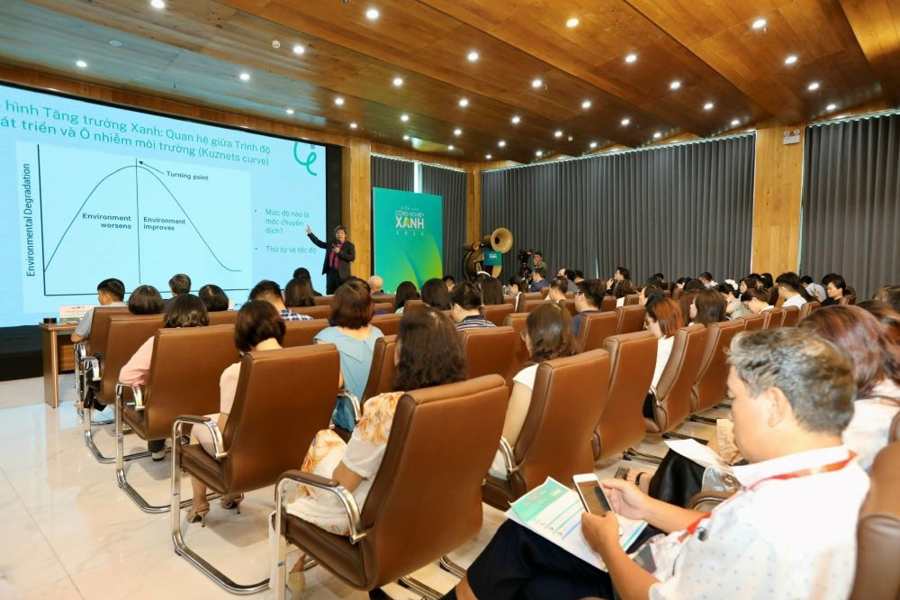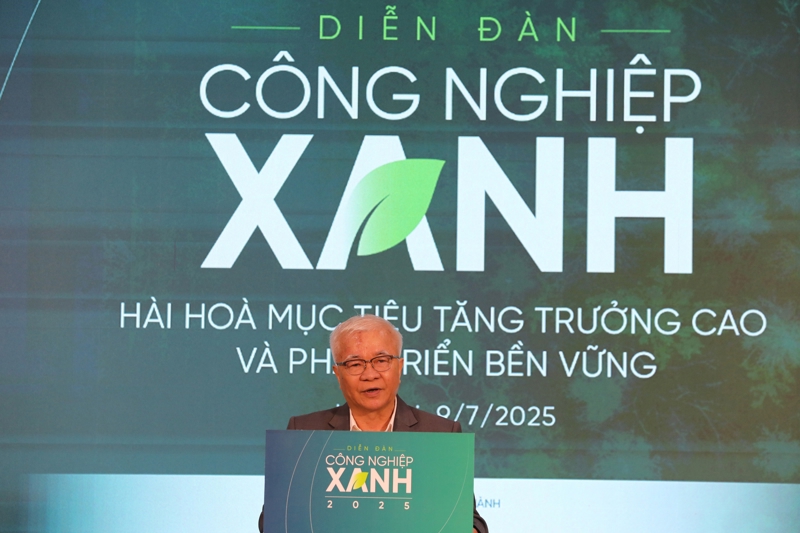Vietnam Economic Times / VnEconomy on July 9 hosted the Green Industry Forum under the theme “Balancing rapid growth and sustainable development”.
The event brought together economic experts and representatives of manufacturing businesses to share their experience and endeavor to find a right path for the green transition process in the industrial sector of Vietnam
In his opening remarks, Dr. Chu Van Lam, Chairman of the Editorial board of Vietnam Economic Times / VnEconomy, emphasized that industry plays a pivotal role in the national economy. To reconcile the pursuit of high economic growth with the imperative of sustainability, transitioning to green industry is an inexorable trend.
Dr. Chu Van Lam noted that Vietnam is entering a new era of growth—an era of the nation's rise. This transformation, he said, is marked by several milestones, one of which is the administrative restructuring that took effect on July 1, 2025, involving the reorganization of administrative units at provincial and commune level, with district-level ones terminated. As of July 9, Vietnam's two-tier local administrative model has operated for nine days, a period symbolizing renewed determination to achieve sustained double-digit growth.
Drawing on international experience, Dr. Chu Van Lam pointed out that countries which have successfully risen often require 15 to 20 years—or in China’s case, even 30 years—of sustained double-digit growth. Vietnam’s ambition to do so, he stressed, reflects an urgent and strategic imperative.
Throughout its development history, industrialization has always been a core driver of Vietnam’s growth. Likewise, no nation has developed without undergoing a process of industrialization. The concept of "industrialization and modernization" is deeply embedded in many Party documents.
However, Dr. Chu Van Lam acknowledged that industrial development globally has often come with environmental trade-offs. He cited Japan as an example. While the country has achieved remarkable industrial success, environmental degradation has been so severe that domestic fish consumption is now avoided in favor of deep-sea imports.
“Our challenge is how to achieve fast, high growth while also protecting the environment. This calls for a twin transition, both green and digital”, Dr. Chu Van Lam stressed, adding that such transformation is what the industrial sector aspires to achieve.
Industry continues to be a cornerstone of Vietnam’s economic structure. As of 2024, the industrial sector accounted for over 31 per cent of GDP. While this proportion is not expected to grow substantially due to the rising dominance of services, industry remains decisive in determining whether the economy can “go green.”
Dr. Chu Van Lam further emphasized that green transformation is not just a trend but an imperative. Without green certifications, Vietnamese products will struggle to integrate into the global market or meet international standards. This is not only a requirement imposed by globalization but also a pressing internal demand of Vietnam’s economy.
Agreeing, Mr. Nguyen Ba Hung, Chief economist of the Asian Development Bank in Vietnam, noted that in the past, it was widely assumed that economic growth must come hand-in-hand with increased resource extraction, often at the expense of the environment.
However, this model is no longer sustainable, as continuing along this path would impose enormous long-term costs on the economy. The objective of green growth, he explained, is to maintain high economic growth while gradually reducing resource consumption and minimizing environmental damage.
He illustrated his point with a simple example: if the size of the economy were to double, it should not necessarily require a doubling of resource use. Instead, resource demand might only need to increase by 20–30 per cent, thanks to advances in technology, innovations in production processes, and improvements in efficiency.
This shift represents a transformation from a linear growth model to a circular economy, and from development that involves environmental trade-offs to development that avoids them. From an environmental standpoint, under the traditional model, faster growth often resulted in greater environmental harm. But today, we have the opportunity not only to reduce damage but to make a positive environmental contribution through green technologies.
“This means that instead of harming the environment, businesses can actually help restore or improve it, for example, through waste treatment or air pollution reduction”, Mr. Nguyen Ba Hung explained at the forum.

Citing international experience, he noted that several countries have successfully achieved economic growth while simultaneously cutting emissions, demonstrating that pursuing both goals is not only possible but increasingly necessary.
The key question, he said, is whether Vietnam has the will to join this global trend. “I believe that with the Government’s issuance of the National Green Growth Strategy for 2021-2030 period, vision to 2050, we’ve already shown a clear policy-level commitment”, Mr. Nguyen Ba Hung noted.
“However, turning that commitment into reality will require investment in green technologies, a shift in business models, and a broader transformation of the national growth paradigm from the enterprise level to the macroeconomic scale”, he emphasized.









 Google translate
Google translate